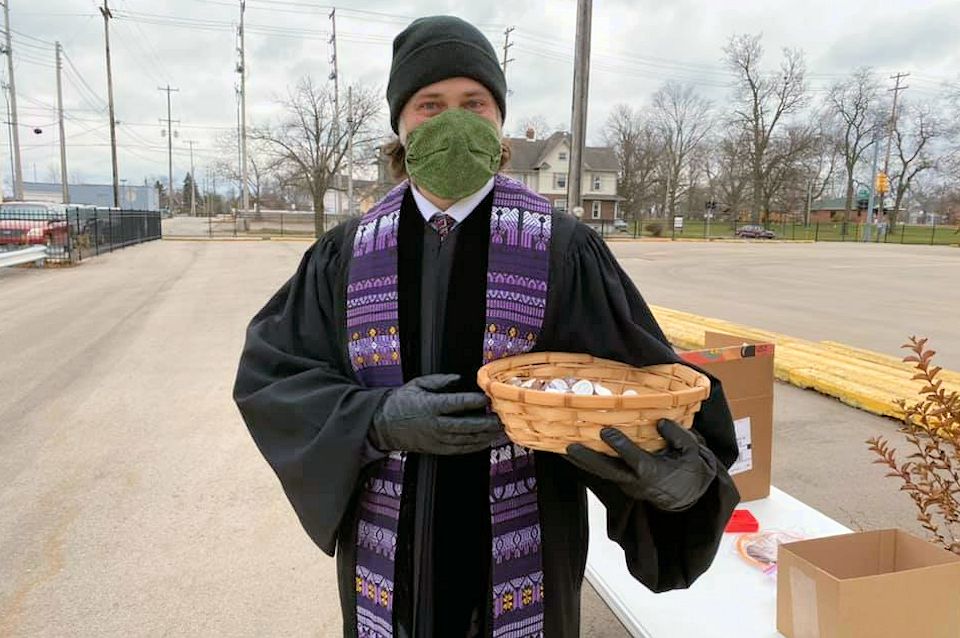Michigan pastors see signs of hope even as the pandemic hangs on. Centered in Christ, they are partnering with laypersons in their congregations to “build a new kind of church.”
JOHN E. HARNISH
Michigan Conference Communications
The numbers confirm what we have all experienced. An AP-NORC poll in October 2021, reports that among mainline Protestants, 14% said they are attending worship once a week, compared to 16% in 2019. Among evangelical Protestants, 37% report weekly attendance compared to 42% in 2019. Everywhere, churches large and small have taken a hit in worship attendance, including the United Methodist churches of Michigan.
One factor has been the move to online worship. The pandemic forced churches to go online for worship, small groups, and committee meetings. Pastors had to learn new ways of providing pastoral care, funerals, and weddings. Music staff discovered ways of connecting with choir members and education staff shifted to Zoom classes. Many pastors, like the Rev. Jeremy Peters at Flint Court Street, admit, “One of the things I had to learn in the early months of the pandemic was how to say, ‘I don’t know how to do this’. I learned I had to ask for help.”
For pastors of small churches, COVID brought the unexpected demand for new technology often in areas with poor internet service and many elderly members without computers. Large membership churches have seen fewer of their less frequent worshipers returning while many of their regulars opt for online worship. so, congregations that were using attendance as a primary metric for measuring success feel they are failing.
To further complicate church life, finances have been negatively affected by additional expenses for video equipment and technical staff coupled with the decline in offerings when people are not in worship.
And of course, pastors bear the weight of it all.
As caring persons and as the primary leader of the congregation, pastors are often torn between pastoral ministry and hard decision-making, feeling both the pain and the responsibility the pandemic has created. Regretfully, rather than pulling together in the crisis, some congregations turn on their pastors and blame them for declining attendance and finances. In fact, Christian Century magazine reports that 38% of Protestant clergy have considered leaving the ministry in the past year.
With the coming of the New Year, the Rev. Ryan Wenburg, Pastor at Frankenmuth United Methodist Church, says, “I’m on the brink of burnout, yet I’m pushing through because I know it’s my calling. I’m trying to hold a congregation together in the midst of a pandemic, denominational uncertainty, and political restlessness. And yet,” he says, “there’s joy too. I am finding joy in helping others see the presence of Christ in the midst of the chaos while learning to live with the now constant realities of COVID.”
The Rev. Bill Chu, pastor of Shepherd United Methodist Church shares the same sentiment. He admits, “Nearly two years of social distancing has darkened my inner world. I often feel like I am just holding on, just trying to survive instead of pushing to thrive.” And yet, he looks to the future with confidence. “Our faith communities exist for troubled times just like this. The church needs to be the light that shines in the darkness. I’m tired of playing defense; I want to get back on offense. It’s time for us to wage an assault on the gates of Hades.”
The Rev. Melanie Carey, lead pastor at Nardin Park UMC, says, “While ministry has always been a challenge, this season has been like none other I have experienced– even when I was a District Superintendent or the Assistant to the Bishop.” Reflecting on the past year, she said, “In the beginning, people rose to the occasion and were beyond gracious with one another and with church leaders. Sadly, as the crisis has continued, the graciousness has often evaporated, and people’s frustration has boiled over into personal attacks, blame, and anger toward one another and toward clergy.”
Even so, she sees signs of hope in the faithful people who carry on. Carey says, “While I see fewer people willing to serve, the people who graciously offer themselves are all in. They are willing to expand their capacities for resilience through this time of great change. On the other side of this crisis, their leadership will help us build a new kind of church. Another place I find hope is in clergy covenant groups as we work through the challenges together.”
As Rev. Chu says, “Our faith communities exist for troubled times such as this,” and with Rev. Wenberg, many pastors are finding joy helping their congregations discover Christ present, even in the face of another COVID New Year. The greatest hope for the church will be found in the commitment of pastors and laity who work together to discover Christ in the midst, leading us into a New Year and a new future.
It’s not scripture, but it’s close. It’s the opening of Amanda Gorman’s latest poem “New Day”:
May this be the day we come together…
We are learning that though we weren’t ready for this,
we have been readied by it.
We steadily vow that no matter
How we are weighed down,
We must always pave a way forward.
This hope is our door, our portal.
Even if we never get back to normal,
someday we can venture beyond it,
To leave the known and take the first steps.
So let us not return to what was normal,
But reach toward what is next.
Last Updated on January 18, 2022

